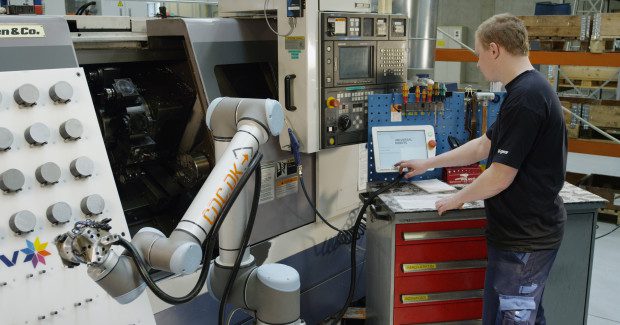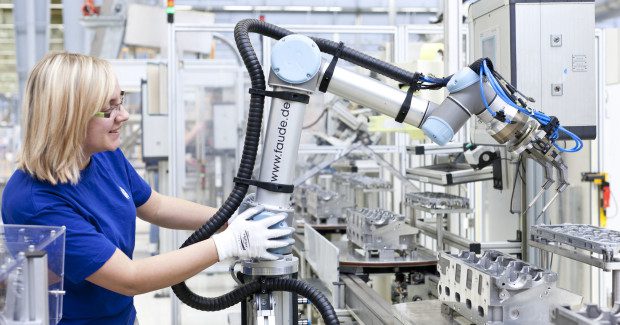Reinventing Industrial Robotics
Lightweight, 6-axis UR5 and UR10 collaborative industrial robot arms from Universal Robots are for shops that thought robots were too expensive, cumbersome, and hard to program and integrate into existing production.
Posted: April 4, 2016
Shops can boost their productivity in metal fabrication and machining by automating virtually any operation with lightweight, 6-axis UR5 and UR10 collaborative industrial robot arms from Universal Robots USA, Inc. (East Setauket, NY). The UR5 and UR10 are aimed at shops that thought robots were too expensive, cumbersome, and hard to program and integrate into existing production. These 6-axis robots improve the quantity and quality of output by making it possible for machine shops to automate tool and part precision through production adjustments for various processes, materials, and specialized part demands. They can work alongside personnel and generally require no safety shielding in 80 per cent of installations. They are easily moved around the production area as a plug-and-play system with a simple user interface that lets employees with no previous programing experience quickly set up and operate them.
Once purchased, shops can expect a steady stream of software upgrades that gives them access to all the new features on the latest robots to leave the factory, making their investment future-proof. Instead of expensive sensor technology, UR5 and UR10 robotic arms use a unique patented technology called force control to measure electrical current in the joints to determine force and movement. The innovation enables the robot to undercut the price of other automated solutions for small and medium-sized shops that demand a fast return on investment. Besides the robot’s low initial cost, it operates very cost-efficiently and is profitable in only six to eight months.
Using the unique advanced force control feature, these robots can operate with an additional force component that enables more complex automation processes to be performed in buffing or polishing applications. “Advanced force control is a unique feature for this type of collaborative robot,” explained Ed Mullen, the national sales manager for Universal Robots in North America. “We can now automate manual tasks previously not possible due to the exact amount of force exertion needed in the application.” For example, a torso application has been developed that uses two robotic arms to mimic the way a human can grip objects by using two arms. The two robotic arms are programmed to work in unison and hold objects between them without crushing using variable force.
These 6-axis robot arms are ideal for a wide variety of applications, from machine tending a small CNC lathe to large automobile assembly lines. The UR5 and UR10 are named after their respective payload in kilos (11 lb for the UR5 and 22 lb for the UR10). With a reach capacity up to 51 in, speed of 39 ips and repeatability of ± .004 in, each 6-axis robot enables quick, dexterous precision handling of even the smallest items. “We decided to make programming intuitive by developing a graphical user interface combined with a “teaching function” that allows the user to simply grab the robot arm and show it how a movement should be performed,” explained Esben Østergaard, the founder and chief technology officer at Universal Robots A/S (Odense, Denmark). “The robot can be integrated into any production process very quickly. Our experience shows this is generally done in a few hours.”
If the robots come into contact with an employee, they will automatically stop operating. The force delivered in the collision does not cause bodily harm, adhering to the current safety requirements on force and torque limitations. Tools used by the robot and other unique factors of each application should be incorporated in a full risk assessment for every installation before deciding if safety guarding is necessary or not.
Universal Robots USA, Inc., 11 Technology Drive, East Setauket, New York 11733, 631-610-9664, ur.na@universal-robots.com, www.universal-robots.com.












